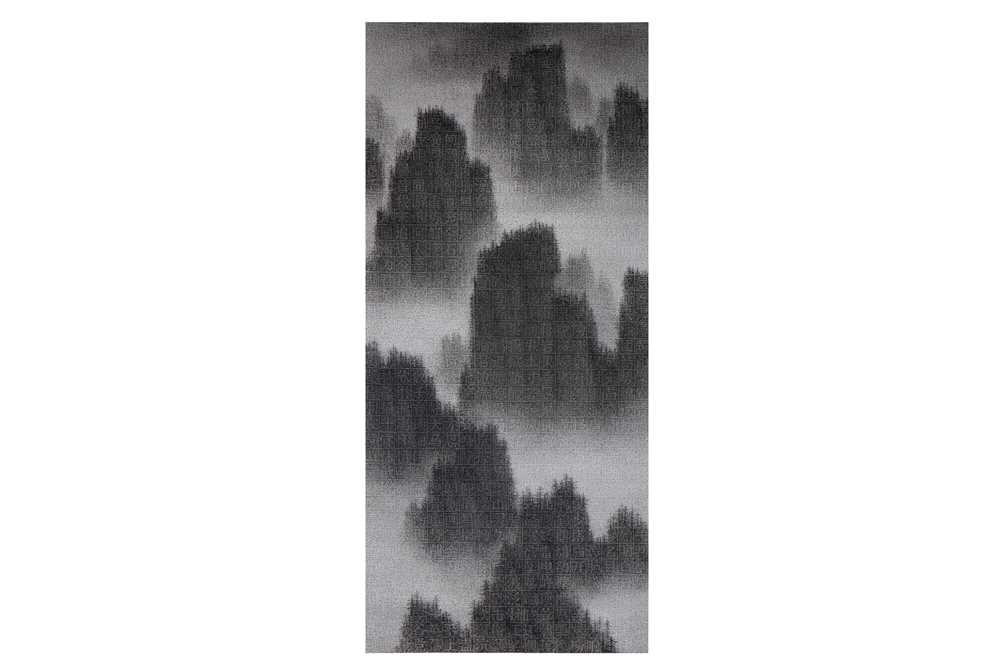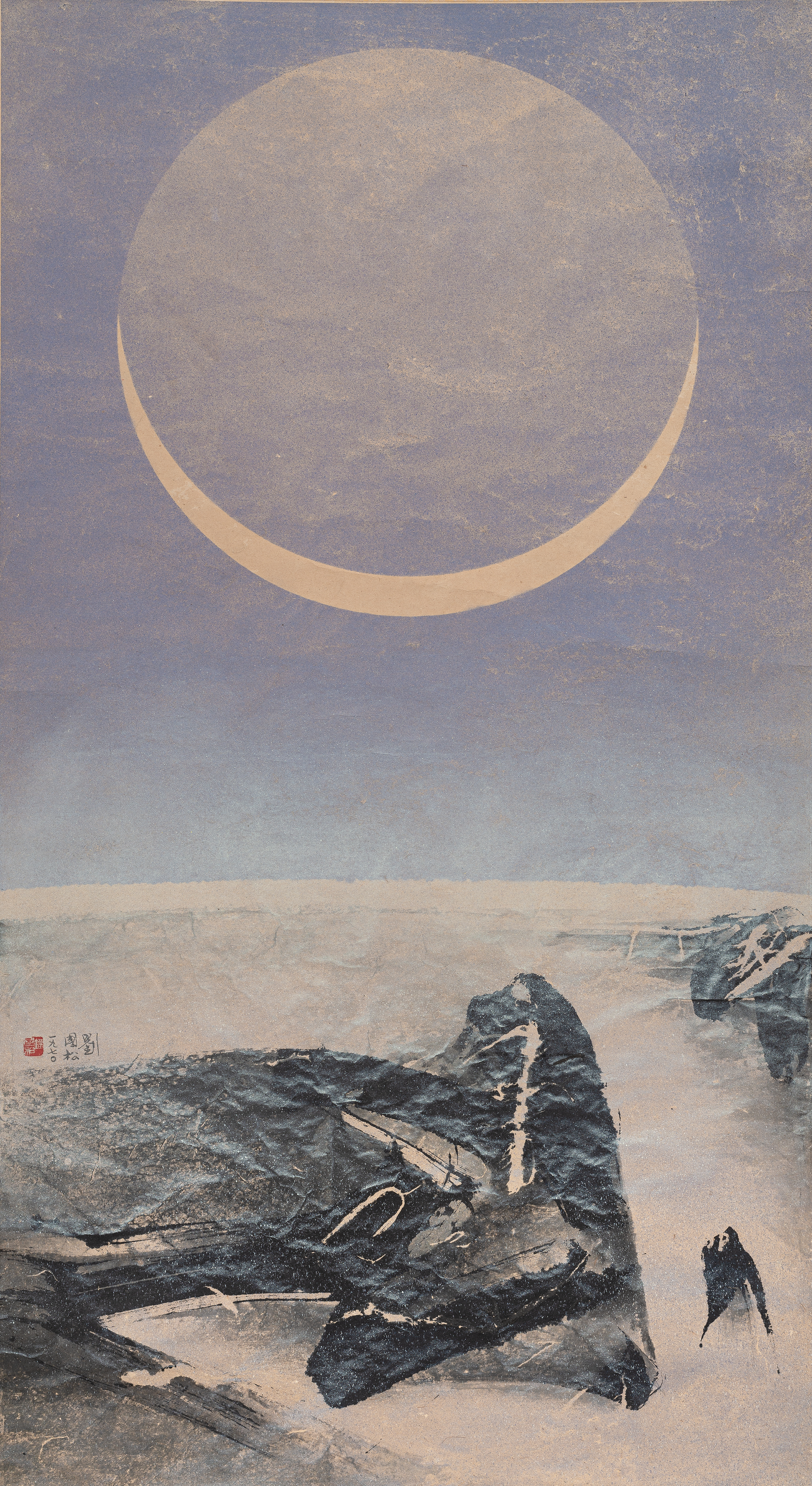LEE CHUN-YI (B. 1965)
Mao Triptych: Wan Sui, Wan Shui, Wan Wan Sui
LEE CHUN-YI (B. 1965) Mao Triptych: Wan Sui, Wan Shui, Wan Wan Sui A set of three scrolls, mounted and framed Ink on paper Left and right scroll each measures 182.5 x 76 cm. (72 x 30 in.) Central scroll measures 244 x 122 cm. (96 x 48 in.) Executed in 2008 PROVENANCE The Origo Collection EXHIBITED London, Saatchi Gallery, Ink: The Art of China , 19 June-5 July, 2012 LITERATURE Beyond China: The New Ink Painting from Taiwan, Michael Goedhuis, London, 2009, p. 32 Chinese Ink Painting Now , Distributed Art Publishers, Inc., New York, 2010, p. 230 Dany Chan, ‘Painting Mao’s Words: an Exercise in Landscape Painting by Lee Chun-yi’, Modern China Studies , Vol. 18, No. 2, 2011, p. 106 Ink: The Art of China , Michael Goedhuis Publishing, London, 2012, pp. 40-41 IN CONVERSATION WITH LEE CHUN-YI C: Christie’s L: Lee Chun-yi (interview conducted in Chinese) C: What inspired the Mao Triptych? L: This work was created in 2008 when the Beijing Olympics took place, which showcased a strong, prosperous China to the world after thirty years of the economic reform. While the global Chinese community rejoiced in the success of the country, I on the other hand recalled the fear of the future before the Handover of Hong Kong in 1997. Inspired by these contrasting attitudes I created the triptych based on the theme of Mao Zedong, in order to reflect on the tumultuous development of recent history. Visually, the shape of the central portrait is based on the stone steles of the Han Dynasty with a sense of solemn mourning. The landscapes on both sides are inspired by the calligraphic couplet that accompanies the central painting. The work as a whole thus resembles the character ‘mountain’ in Chinese. The mirroring landscapes are also an allegory for the opposite political ideologies. The paintings are comprised of the characters ‘mao’, ‘ze’ and ‘dong’ in different orientations – or even upside-down – to symbolise the uncertainty underneath a seemingly stable society. C: Can you describe the process of your artistic production and technique? L: My work is deeply inspired by the Chinese seals and ink rubbings. I use a soft wood that absorbs ink easily, cut into small cubes, and stamp with them on the paper – so that stamping, rather than brushwork, form the composition of my paintings. As there are rich textures and lines on the wood itself, the process can achieve a visual effect similar to rubbings of stone steles. Hence, I carefully carve characters and images onto thick cardboard before using soft wood cubes to create the images. This innovative technique departs from the traditional transferral of characters of stone stele rubbings; instead, showing the original markings of the characters, my work also aims to fully, precisely represent figurative images in the painting. It is in fact a rather time-consuming process. C: How has your art evolved since Mao Triptych in 2008? L: Because of my background I am particularly concerned with the politics of Mainland China, Hong Kong and Taiwan. They propel me to produce works on these themes. Politics has remained important in my work after 2008, and my paintings continue to reflect my personal concerns. My mode of expression, however, has become increasingly subtle. The grid forms of the paintings deconstruct the whole visual imagery in a rational and critical way, in order to allegorise the power struggles and fragmented governments across the strait. In terms of subject-matter, I have branched out from landscape and figures to explore new subjects such as flowers, pine trees and rocks. These symbolic imageries are employed to express reflections on social political issues, infusing the traditional Chinese painting medium with a sense of the contemporary.
LEE CHUN-YI (B. 1965)
Mao Triptych: Wan Sui, Wan Shui, Wan Wan Sui
LEE CHUN-YI (B. 1965) Mao Triptych: Wan Sui, Wan Shui, Wan Wan Sui A set of three scrolls, mounted and framed Ink on paper Left and right scroll each measures 182.5 x 76 cm. (72 x 30 in.) Central scroll measures 244 x 122 cm. (96 x 48 in.) Executed in 2008 PROVENANCE The Origo Collection EXHIBITED London, Saatchi Gallery, Ink: The Art of China , 19 June-5 July, 2012 LITERATURE Beyond China: The New Ink Painting from Taiwan, Michael Goedhuis, London, 2009, p. 32 Chinese Ink Painting Now , Distributed Art Publishers, Inc., New York, 2010, p. 230 Dany Chan, ‘Painting Mao’s Words: an Exercise in Landscape Painting by Lee Chun-yi’, Modern China Studies , Vol. 18, No. 2, 2011, p. 106 Ink: The Art of China , Michael Goedhuis Publishing, London, 2012, pp. 40-41 IN CONVERSATION WITH LEE CHUN-YI C: Christie’s L: Lee Chun-yi (interview conducted in Chinese) C: What inspired the Mao Triptych? L: This work was created in 2008 when the Beijing Olympics took place, which showcased a strong, prosperous China to the world after thirty years of the economic reform. While the global Chinese community rejoiced in the success of the country, I on the other hand recalled the fear of the future before the Handover of Hong Kong in 1997. Inspired by these contrasting attitudes I created the triptych based on the theme of Mao Zedong, in order to reflect on the tumultuous development of recent history. Visually, the shape of the central portrait is based on the stone steles of the Han Dynasty with a sense of solemn mourning. The landscapes on both sides are inspired by the calligraphic couplet that accompanies the central painting. The work as a whole thus resembles the character ‘mountain’ in Chinese. The mirroring landscapes are also an allegory for the opposite political ideologies. The paintings are comprised of the characters ‘mao’, ‘ze’ and ‘dong’ in different orientations – or even upside-down – to symbolise the uncertainty underneath a seemingly stable society. C: Can you describe the process of your artistic production and technique? L: My work is deeply inspired by the Chinese seals and ink rubbings. I use a soft wood that absorbs ink easily, cut into small cubes, and stamp with them on the paper – so that stamping, rather than brushwork, form the composition of my paintings. As there are rich textures and lines on the wood itself, the process can achieve a visual effect similar to rubbings of stone steles. Hence, I carefully carve characters and images onto thick cardboard before using soft wood cubes to create the images. This innovative technique departs from the traditional transferral of characters of stone stele rubbings; instead, showing the original markings of the characters, my work also aims to fully, precisely represent figurative images in the painting. It is in fact a rather time-consuming process. C: How has your art evolved since Mao Triptych in 2008? L: Because of my background I am particularly concerned with the politics of Mainland China, Hong Kong and Taiwan. They propel me to produce works on these themes. Politics has remained important in my work after 2008, and my paintings continue to reflect my personal concerns. My mode of expression, however, has become increasingly subtle. The grid forms of the paintings deconstruct the whole visual imagery in a rational and critical way, in order to allegorise the power struggles and fragmented governments across the strait. In terms of subject-matter, I have branched out from landscape and figures to explore new subjects such as flowers, pine trees and rocks. These symbolic imageries are employed to express reflections on social political issues, infusing the traditional Chinese painting medium with a sense of the contemporary.

.jpg)


.jpg)
.jpg)
.jpg)




Try LotSearch and its premium features for 7 days - without any costs!
Be notified automatically about new items in upcoming auctions.
Create an alert